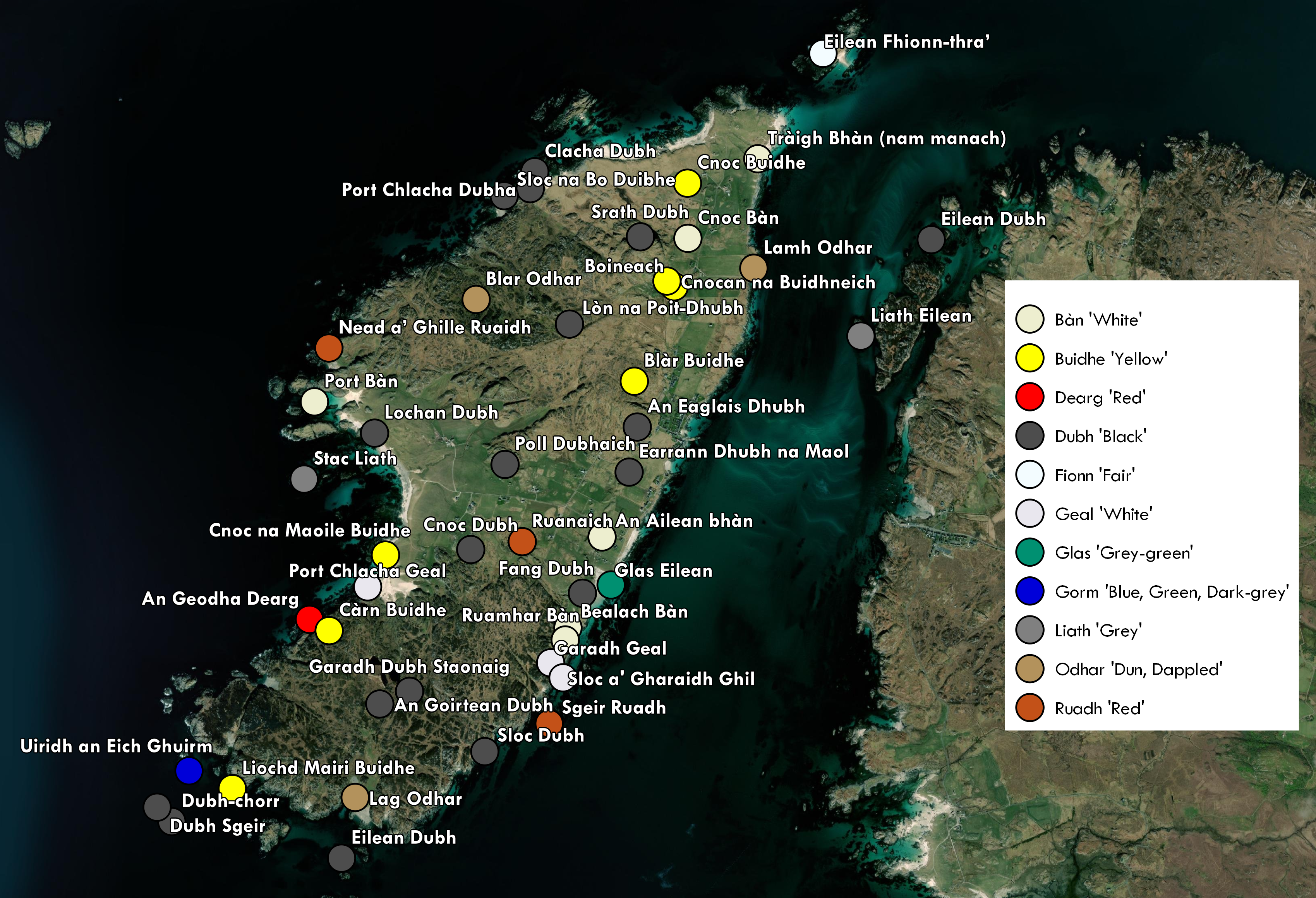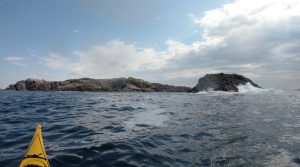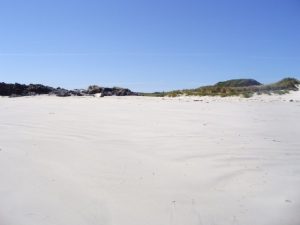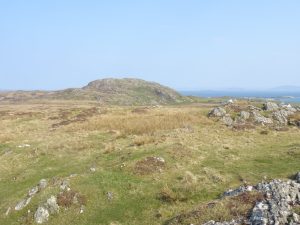A series of Advent Tweets in December last year by @ChronHib (find it here) sparked this investigation into how colours are used in the Iona namescape. So, for our fourth blog feature, I will be taking a closer look at place-names which contain references to colour (colour names) including a more detailed discussion of Blàr Buidhe, a place-name which raises several interesting questions.
A brief glance at Iona’s namescape makes it immediately obvious that colour plays an important role. Visitors to Iona will be aware of its visually striking landscape, which has resulted in numerous colour names. Undoubtedly, these colours have also contributed to the perception of Iona as a place of religious and cultural significance. We need only look at some of the 18th and 19th century visitors’ accounts describing their impressions of Iona to see this. Colour features prominently in descriptions of the pebbles found in the area around what is known as St Columba’s Bay, more specifically at Port a’ Churaich. According to Martin ‘There are many pretty variegated Stones in the shore below the Dock ; they ripen to a green Colour, and are then proper for carving’. The anonymous account of Iona from 1771 states that ‘Some of these pebbles are green, some blue, and others reddish, but none of them have any extraordinary transparency of colour’ (Sharpe 2012, p. 185). Pennant describes it as ‘a pebbly beach, mixed with variety of pretty stones, stones such as violet-colored Quartz, Nephritic stones, and fragments of porphyry, granite and Zæblitz marble’. The variety present in these descriptions serves as a reminder of the importance of individual perception and experiences when studying colour.

The map included here shows the distribution of Iona colour names. Entries are derived from three main sources: OS maps, D. Munro Fraser’s appendix to the Ritchies’ map of Iona, and Mairi MacArthur’s (1989, pp. 112-4) list of unmapped place-names. It is noteworthy that more than 67% of the colour names outlined here are not found on any OS maps, illustrating the value of considering the names of minor topographical features (microtoponyms) recorded in various local sources. Although translations of colour terms from Gaelic to English are provided in the legend, it should be noted that these translations do not necessarily cover the full semantic range contained in each colour. Since the publication of Brent Berlin & Paul Kay’s Basic Color Terms (1969), the difference in perception and categorisation of colour in various languages has been firmly established. For example, the colour glas can cover anything from ‘grey, pale, ashy’ to ‘green, as grass, unripe corn’ (Dwelly s.v. glas). For further discussion of the nuances of different colour terms in Gaelic see Bateman & Purser (2020, pp. 184-201).
The place-names presented on this map illustrate the richness of colours used to describe the landscape. Eleven different colour terms are present in the data presented here (see map). Dubh ‘black’ is by far the most common one, found in eighteen place-names (39% of the material). Terms denoting a white colour, including geal, bàn, and fionn are also found in a considerable portion of the place-names outlined on the map with ten entries (just under 22%). This is consistent with observations made in other areas of Scotland and elsewhere. Leonie Dunlop and Carole Hough (2014, p. 314) observe that ‘The predominance of black has been noted in the place-names of many languages, where it describes hills, rocks, water and so on (Rätsep 2012). The ubiquity of white similarly reflects a range of uses encompassing white stone, clear water chalky soil and blossom (Hough 2003).’[1]
We should note that a relatively large number of place-names outlined on the map here do not follow the typical word order for Gaelic place-names where we would expect noun (generic element) to be followed by a colour adjective (specific element). Five place-names (Dubh-chorr, Dubh Sgeir, Eilean Fhionn-thra’, Glas Eilean & Liath Eilean) reflect formations where the colour term (specific element) precedes the generic element. This is a characteristic of place-names coined with certain colour adjectives, especially fionn and dubh (PNF 5, p. 169).

The place-names are predominantly of a topographical nature, with the exception of An Eaglais Dhubh (see below). Colour terms in place-names are, perhaps unsurprisingly, often used to describe the visual appearance of a feature in the landscape. This is almost certainly what we see in place-names like Dubh Sgeir ‘Black skerry’ and Tràigh Bhàn nam Manach ‘White strand of the monks’, referring to the black rock surface and white sands respectively (see images).
Sometimes the interpretation is not quite as straightforward. The farm of Ruanaich is given by D. Munro Fraser as ‘Place of red flowers’. Used in this way, it may refer to the red colouring of the flowers. However, the name may conceivably denote a specific flower, ruanaidh ‘Sheep’s sorrel (rumex acetosella)’ (Dwelly s.v. ruanaidh), found on Iona’s hills (Millar 1972 s.v. Rumex acetosella). An alternative and perhaps more likely suggestion made by Alasdair Whyte (pers. comm.) is G ruan ‘Kind of weed which gives a reddish colour’ (Dwelly s.v. ruain; also see eDIL s.v. rúan) with –ach as a place-name forming suffix (see PNF 5, p. 277). But does it matter if the place-name in question was coined to denote the colour red or the name of a plant? Strictly speaking, if we are studying place-names which contain colour terms, references to the names of flowers etc. should be excluded. Dunlop & Hough (2012, pp. 317-8) deal with similar issues and exclude names that ‘were considered too uncertain’, concluding that often ‘the reason for the name can only be established from direct observation’. The data presented here uses an inclusive approach; where local sources have interpreted the element in question as denoting a colour, it has been included.

With other place-names we are on more certain ground, but rather than describing the physical appearance of a particular feature, the colour term is used metaphorically. For instance, the Iona Nunnery was locally known as An Eaglais Dhubh ‘The black church’ which seems to be a reference to the wearing of black habits by the nuns (Mairi MacArthur pers. comm.). This is supported by the 1771 anonymous account of Iona, which has the following to say about the nunnery: ‘It is called in Erse Manastear na’n Caileach dúbh. The epithet du’bh, or black, is affixed to them, because they wore black veils’ (Sharpe 2012, pp. 192, 239).
In a relatively large portion of the place-names, the colour term does not refer to a topographical feature, but to a person, animal or even inanimate objects. A notable example is Uiridh an Eich Ghuirm, given by D. Munro Fraser as ‘Bed (couch) of the dark-grey horse’, referring to a small rocky island off the south-western coast of Iona. Some of these names also have place-lore attached which explain the colour association. Lòn na Poit-Dhubh ‘Marsh of the black pot’ was ‘where the still was said to have been hidden from the customs men’ (MacArthur 1989, p. 113).[2] Other inanimate objects also deserve a mention. In particular, the famous Leac Dhubh ‘Black stone’ of Iona features frequently in accounts of the island (often in the plural), where it is described as ‘grey’ by Martin and ‘greyish’ by Boswell.
For the second part of this discussion, I will consider the place-name Blàr Buidhe in greater detail. The name refers to a field to the west of Reilig Odhrain and at a glance appears to be a relatively straightforward place-name, containing G blàr ‘plain, field’ and G buidhe ‘yellow’. Buidhe may refer to the typical yellow/green colour of the grass of Iona (Mairi MacArthur pers. comm.). At any rate, this is how it is interpreted in D. Munro Fraser’s appendix, where it is given as ‘Blar buidhe. Yellow plain.’ Similarly, both the OS Name Books and Reeves give the name as ‘Yellow Plain’ and ‘Yellow field’ respectively. However, the title of a drawing by Sir Henry Dryden from 1875 adds a further dimension to this name. His sketch and plan of the cairn located in Blàr Buidhe gives the name of the cairn as Tigh Fhinn ‘House of Finn’. According to RCAHMS Argyll vol. 4:
The cairn was at that time [1875] known locally as Tigh Fhinn (‘Finn’s House’). Ancient burial-mounds were often associated with the Irish hero Finn, e.g. Greadal Fhinn, Ardnamurchan (Inventory of Argyll, 3, No. 3), but the name of this cairn may have been suggested by its location in Blàr Buidhe (‘yellow field’), since the Gaelic tale recounting the adventures of Finn in the house of the Irish giant Blàr Buidhe was still current in Argyll in the 19th century.
As stated here, the story of Finn in the house of Blàr Buidhe is well-attested and appears in several 19th-century accounts, including J.F. Campbell’s translation from Gaelic which relates how Finn was ‘in the house of the Yellow Face, unable to rise or to sit’ (also see another version of the story here: Tobar an Dualchais). We can thus assume that at least by the 19th century an association with Blàr Buidhe and the story of Finn and the giant had been made. Did this reflect local opinion of the 19th century or was it simply an antiquarian assumption? After all, Dryden seems to be the only source to record the name Tigh Fhinn.

We might also speculate on the origins of the name for the giant. As mentioned above, Campbell translates his name as ‘Yellow Face’, but considering how ubiquitous Blàr Buidhe is as a place-name, it seems plausible that the name of the giant was originally derived from one of these names, in Argyll or elsewhere. Thus, the name Tigh Fhinn may ultimately be the result of a migratory narrative which emerged from a (re-)interpretation of an existing place-name.
If there was ever any doubt, this blog makes it apparent just how prominent colour is in the Iona namescape. A range of colour terms are used to describe various aspects of place-names including their physical appearance, the presence of an animal, person or object, and sometimes in a metaphorical sense. The large number of colour names not recorded on any OS maps also demonstrates the importance of carefully considering the microtoponymy in any given area to fully understand how people view the landscape. Blàr Buidhe serves as a reminder of the virtue of considering a range of sources when analysing place-names and that what appears to be a semantically straightforward name may have multiple dimensions.
Notes
[1] also see Rätsep, 2012. ‘Colour term “black” in Estonian place names’, Eesti ja Soome-Ugri Keeleteaduse Ajakiri 3, pp. 129-54 & Hough, 2003. ‘Onomastic Uses of the Term “White”’, Nomina 26, pp. 83-92.
[2] Also see Dwelly s.v. poit-dhubh.
References
Bateman, M. & Purser, J. 2020. Window to the west: culture and environment in the Scottish Gàidhealtachd (Isle of Skye: Clò Ostaig).
Berlin, B. & Kay, P. 1969. Basic color terms: their universality and evolution (Berkeley: University of California Press).
Dunlop, L. & Hough, C. 2014. ‘Colour terms in the names of coastal and inland features: a study of four Berwickshire parishes’, in Colour studies: a broad spectrum, eds. Anderson, W., C. P. Biggam, C. Hough and C. Kay (Amsterdam: John Benjamins), pp. 307-322.
MacArthur, E. M. 1989. ‘The Island of Iona: aspects of its social and economic history from 1750 to 1914’ (PhD thesis, University of Edinburgh).
Meek, D. 1998. ‘Place-names and literature: evidence from the Gaelic ballads’, in The uses of place-names, ed. S. Taylor (Edinburgh: Scottish Cultural Press), pp. 147-68.
Millar, J. M. 1972 [2006]. Flowers of Iona (Iona: The New Iona Press).
PNF = Taylor, S. with G. Márkus (2006-2012), The place-names of Fife, 5 vols (Donington: Shaun Tyas).
Sharpe, R. 2012. Iona in 1771: ‘Gaelic tradition and visitors’ experience’, The Innes Review 63, Issue 2, pp. 161-259.
